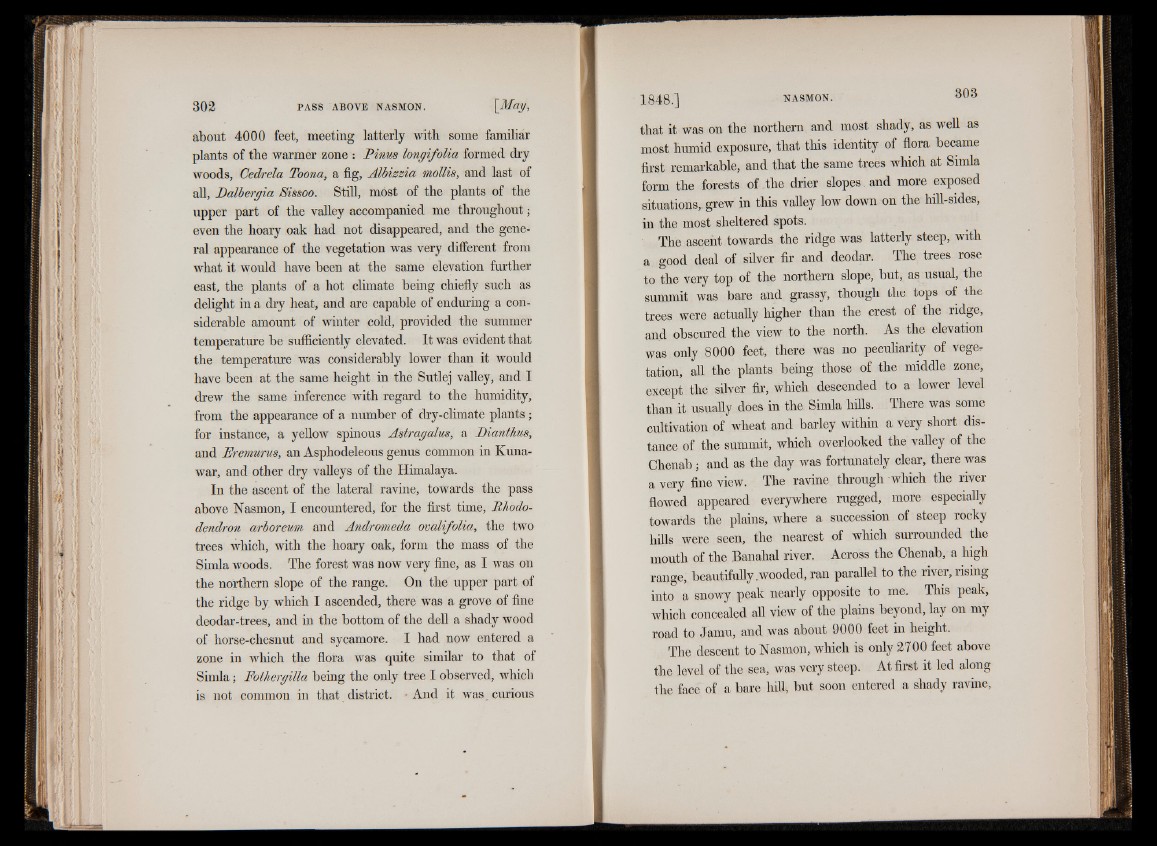
about 4000 feet, meeting latterly with some familiar
plants of tbe warmer zone : Pinus longifolia formed dry
woods, Cedrela Toona, a fig, Albizzia mollis, and last of
all, Dalbergia Rissoo. Still, most of the plants of the
upper part of the valley accompanied me throughout;
even the hoary oak had not disappeared, and the general
appearance of the vegetation was very different from
what it would have been at the same elevation further
east, the plants of a hot climate being chiefly such as
delight in a dry heat, and are capable of enduring a considerable
amount of winter cold, provided the summer
temperature be sufficiently elevated. It was evident that
the temperature was considerably lower than it would
have been at the same height in the Sutlej valley, and I
drew the same inference with regard to the humidity,
from the appearance of a number of dry-climate plants;
for instance, a yellow spinous Astragalus, a Dianthus,
and Eremurus, an Asphodeleous genus common in Kuna-
war, and other dry valleys of the Himalaya.
In the ascent of the lateral ravine, towards the pass
above Nasmon, I encountered, for the first time, Rhododendron
arhoreum and Andromeda ovalifolia, the two
trees which, with the hoary oak, form the mass of the
Simla woods. The forest was now very fine, as I was on
the northern slope of the range. On the upper part of
the ridge by which I ascended, there was a grove of fine
deodar-trees, and in the bottom of the dell a shady wood
of horse-chesnut and sycamore. I had now entered a
zone in which the flora was quite similar to that of
Simla; Fothergilla being the only tree I observed, which
is not common in that district. • And it was. curious
that it was on the northern and most shady, as well as
most humid exposure, that this identity of flora became
first remarkable, and that the same trees which at Simla
form the forests of The drier slopes and more exposed
situations,, grew in this valley low down on the hill-sides,
in the most sheltered spots.
The ascent towards the ridge was latterly steep, with
a good deal of silver fir and deodar. The trees rose
to the very top of the northern slope, but, as usual, the
summit was bare and grassy, though the tops of the
trees were actually higher than the crest of the ridge,
and obscured the view to the north. As the elevation
was only 8000 feet, there was no peculiarity of veger
tation, all the plants being those of the middle zone,
except the silver fir, which descended to a lower level
than it usually does in the Simla hills. There was some
cultivation of wheat and barley within a very short distance
of the summit, which overlooked the valley of the
Chenab; and as the day was fortunately clear, there was
a very fine view. The ravine through which the river
flowed appeared everywhere rugged, more especially
towards the plains, where a succession of steep rocky
hills were seen, the nearest of which surrounded the
mouth of the Banahal river. Across the Chenab, a high
range, beautifully.wooded, ran parallel to the river, rising
into a snowy peak nearly opposite to me. This peak,
which concealed all view of the plains beyond, lay on my
road to Jamu, and was about 9000 feet in height.
The descent to Nasmon, which is only 2700 feet above
the level of the sea, was very steep. At first it led along
the face of a bare hill, but soon entered a shady ravine,